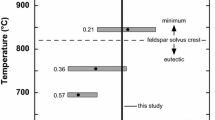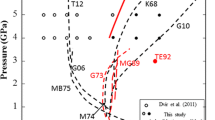Abstract
Peraluminous granitoid magmas are a characteristic product of ultrametamorphism leading to anatexis of aluminous metasedimentary rocks in the continental crust. The mechanisms and characteristic length-scales over which these magmas can be mobilized depend strongly on their melt fraction, because of their high viscosities. Thus, it is of fundamental importance to understand the controls exerted by pressure, temperature and bulk composition of the source material on melt productivity. We have studied experimentally the vapour-absent melting behaviour of a natural metapelitic rock and our results differ greatly from those of previous experimental and theoretical investigations of melt productivity from metamorphic rocks. Under H2O-undersaturated conditions, bulk composition of the source material is the overriding factor controlling melt fraction at temperatures on the order of 850–900° C. Granitoid melts formed in this temperature interval by the peritectic dehydration-melting reaction:
have a restricted compositional range. As a consequence, melt fractions will be maximized from protoliths whose modes coincide with the stoichiometry of the melting reaction. This “optimum mode” (approximately 38% biotite, 32% quartz, 22% plagioclase and 8% aluminosilicate) reflects the fact that generation of low-temperature granitoid liquids requires both fusible quartzo-feldspathic components and H2O (from hydrous minerals). Metapelitic rocks rich in mica and aluminosilicate and poor in plagioclase contain an excess of refractory material (Al2O3, FeO, MgO) with low solubility in low-temperature silicic melts, and will therefore be poor magma sources. Melt fraction varies inversely with pressure in the range 7–13 kbar, but the effect is not strong: the decrease (at constant temperature) over this pressure range is of at most 15 vol% (absolute).
The liquids produced in our experiments are silicarich (68–73 wt% SiO2), strongly peraluminous (2–5 wt% normative corundum) and very felsic (MgO+FeO* +TiO2 less than 3 wt%, even at temperatures above 1000° C). The last observation suggests that peraluminous granitoids with more than 10% mafic minerals (biotite, cordierite, garnet) contain some entrained restite. Furthermore, because liquids are also remarkably constant in composition, we believe that restite separation is more important than fractional crystallization in controlling the variability within and among peraluminous granitoids.
We present liquidus phase diagrams that allow us to follow the phase relationships of melting of silica-and alumina-saturated rocks at pressures corresponding to the mid- to deep-continental crust. Garnet, aluminosilicate, quartz and ilmenite are the predominant restitic phases at temperatures of about 900° C, but Ti-rich biotite or calcic plagioclase can also be present, depending on the bulk composition of the protolith. At temperatures above 950–1050° C (depending on the pressure) the restitic assemblage is: hercynitic spinel+ilmenite+quartz±aluminosilicate. Our results therefore support the concept that aluminous granulites (garnet-spinel-plagioclase-aluminosilicate-quartz) can be the refractory residuum of anatectic events.
Similar content being viewed by others
References
Bergantz GW (1989) Underplating and partial melting: implications for melt generation and extraction. Science 245:1093–1095
Bohlen SR (1984) Equilibria for precise pressure calibration and a frictionless furnace assembly for the piston-cylinder apparatus. Neues Jahrb Mineral Monatsh H.9:404–412
Bohlen SR, Boettcher AL, Wall VJ, Clemens JD (1983) Stability of phlogopite-quartz and sanidine-quartz: a model for melting in the lower crust. Contrib Mineral Petrol 83:270–277
Burnham CW (1979) The importance of volatile constituents. In: Yoder HS (ed) The evolution of the igneous rocks. Princeton University Press, Princeton, pp 439–482
Carroll MR, Wyllie PJ (1990) The system tonalite-H2O at 15 kbar and the genesis of calc-alkaline magmas. Am Mineral 75:345–357
Chappel BW, White AJR, Wyborn D (1987) The importance of residual source material (restite) in granite petrogenesis. J Petrol 28:1111–1138
Clemens JD, Vielzeuf D (1987) Constraints on melting and magma production in the crust. Earth Planet Sci Lett 86:287–306
Clemens JD, Wall VJ (1981) Origin and crystallization of some peraluminous (S-type) granitic magmas. Can Mineral 19:111–131
Didier J (1973) Granites and their enclaves: the bearing of enclaves on the origin of granites. Elsevier, Amsterdam
Dimitriadis S (1978) Some liquid compositions in the peraluminous haplogranite system. Neues Jahrb Mineral Monatsh H.8:377–383
Dymek RF (1983) Titanium, aluminum and interlayer cation substitutions in biotite from high-grade gneisses, West Greenland. Am Mineral 68:880–899
England PC, Thompson AB (1986) Some thermal and tectonic models for crustal melting in continental collision zones. In: Coward MP, Ries AC (eds) Collision tectonics. Geol Soc Spec Publ 19:83–94
Grant JA (1985a) Phase equilibria in partial melting of pelitic rocks. In: Ashworth JR (ed) Migmatites. Blackie, Glasgow
Grant JA (1985b) Decompression melting: an isothermal polybaric liquidus diagram for charnockites (abstract). Geol Soc Am Abstr Program 17:596
Green TH (1976) Experimental generation of cordierite- or garnetbearing liquids from a pelitic composition. Geology 4:85–88
Guidotti CW (1984) Micas in metamorphic rocks (Reviews in Mineralogy 13). Mineral Soc Am, Washington, DC, pp 357–468
Hanchar JM, Miller CF (1990) Lower crustal xenoliths in Tertiary dikes, Old Woman Mountains area, southaestern California: I. Petrology. Geol Soc Am Abstr Program 22:28
Johannes W (1984) Beginning of melting in the granite system Qz−Or−Ab−An−H2O. Contrib Mineral Petrol 86:264–273
Le Breton N, Thompson AB (1988) Fluid-absent (dehydration) melting of biotite in metapelites in the early stages of crustal anatexis. Contrib Mineral Petrol 99:226–237
Miller CF (1985) Are strongly peraluminous magmas derived from pelitic sedimentary sources? J Geol 93:673–689
Miller CF, Watson EB, Harrison TM (1988) Perspectives on the source, segregation and transport of granitoid magmas. Trans R Soc Edinburgh: Earth Sci 79:135–156
Naney MT (1983) Phase equilibria of rock-forming ferromagnesian silicates in granitic systems. Am J Sci 283:993–1033
Nekvasil H, Burnham CW (1987) The calculated individual effects of pressure and water content on phase equilibria in the granite system. In: Mysen BO (ed) Magmatic processes: physicochemical prinicples. Geochem Soc spec Publ 1:433–446
Ortega LA, Gil Ibarguchi JI (1990) The genesis of Late Hercynian granitoids from Galicia (northwestern) Spain: Inferences from REE studies. J Geol 98:189–212
Patiño Douce AE, Humphreys ED, Johnston AD (1990) Anatexis and metamorphism in tectonically thickend continental crust exemplified by the Sevier hinterland, western North America. Earth Planet Sci Lett 97:290–315
Patiño MLG, Patiño Douce AE (1987) Petrologia y petrogenesis del Batolito de Achala, provincia de Córdoba, a la luz de la evidencia de campo. Asoc Geol Argent Rev 42:201–205
Peterson JW, Newton RC (1989) Reversed experiments on biotitequartz-feldspar melting in the system KMASH: implications for crustal anatexis. J Geol 97:465–486
Puziewicz J, Johannes W (1988) Phase equilibria and compositions of Fe−Mg−Al minerals and melts in water-saturated peraluminous granitic systems. Contrib Mineral Petrol 100:156–168
Puziewicz J, Johannes W (1990) Experimental study of a biotitebearing granitic system under water-saturated and water-undersaturated conditions. Contrib Mineral Petrol 104:397–406
Rice JM, Grover TW, Lang HM (1988) P-T evolution of the St. Joe-Clearwater region, northern Idaho. Geol Soc Am Abstr Program 20(7):A18
Rutter MJ, Wyllie PJ (1988) Melting of vapour-absent tonalite at 10 kbar to simulate dehydration-melting in the deep crust. Nature 331:159–160
Segnit RA, Kennedy GC (1961) Reactions and melting relations in the system muscovite-quartz at high pressures. Am J Sci 259:280–287
Shuster RD, Bickford ME (1985) Chemical and isotopic evidence for the petrogenesis of the northeastern Idaho batholith. J Geol 93:727–742
Taylor HP (1988) Oxygen, hydrogen and strontium isotope constraints on the origin of granites. Trans R Soc Edinburgh: Earth Sci 79:317–338
Thompson AB (1982) Dehydration melting of pelitic rocks and the generation of H2O-undersaturated granitic liquids. Am J Sci 282:1567–1595
Thompson AB, Algor JR (1977) Model system for anatexis of pelitic rocks. I. Theory of melting reactions in the system KAlO2−NaAlO2−Al2O3−SiO2−H2O. Contrib Mineral Petrol 63:247–269
Vielzeuf D, Holloway JR (1988) Experimental determination of the fluid-absent melting relations in the pelitic system. Consequences for crustal differentiation. Contrib Mineral Petrol 98:257–276
White AJR, Chappell BW (1977) Ultrametamorphism and granitoid genesis. Tectonophysics 43:7–22
Wooden JL, Bennett VC, Hanchar JM, Miller CF (1990) Lower crustal xenoliths in Tertiary dikes, Old Woman Mountains area, southeastern California: II Pb, Nd and Sr isotopic data. Geol Soc Am Abstr Program 22:95
Author information
Authors and Affiliations
Rights and permissions
About this article
Cite this article
Patiño Douce, A.E., Johnston, A.D. Phase equilibria and melt productivity in the pelitic system: implications for the origin of peraluminous granitoids and aluminous granulites. Contr. Mineral. and Petrol. 107, 202–218 (1991). https://doi.org/10.1007/BF00310707
Received:
Accepted:
Issue Date:
DOI: https://doi.org/10.1007/BF00310707




